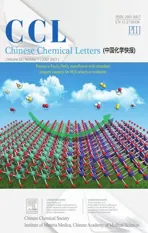The discovery of interfacial electronic interaction within cobalt boride@MXene for high performance lithium-sulfur batteries
2021-10-12BinGunXunSunYuZhngXinWuYueQiuMoxuWngLishungFnNiqingZhng
Bin Gun,Xun Sun,Yu Zhng,Xin Wu,Yue Qiu,Moxu Wng,Lishung Fn,b,*,Niqing Zhng,b,*
a State Key Laboratory of Urban Water Resource and Environment, School of Chemistry and Chemical Engineering, Harbin Institute of Technology, Harbin 150001, China
b Academy of Fundamental and Interdisciplinary Sciences, Harbin Institute of Technology, Harbin 150001, China
ABSTRACT Lithium-sulfur battery is strongly considered as the most promising next-generation energy storage system because of the high theoretical specific capacity.The serious“shuttle effect”and sluggish reaction kinetic limited the commercial application of lithium-sulfur battery.Many heterostructures were applied to accelerate polysulfides conversion and suppress their migration in lithium-sulfur batteries.Nevertheless, the effect of the interface in heterostructure was not clear.Here, the Co2B@MXene heterostructure is synthesized through chemical reactions at room temperature and employed as the interlayer material for Li-S batteries.The theoretical calculations and experimental results indicate that the interfacial electronic interaction of Co2B@MXene induce the transfer of electrons from Co2B to MXene, enhancing the catalytic ability and favoring fast redox kinetics of the polysulfides, and the theoretical calculations also reveal the underlying mechanisms for the electron transfer is that the two materials have different Fermi energy levels.The cell with Co2B@MXene exhibits a high initial capacity of 1577 mAh/g at 0.1 C and an ultralow capacity decay of 0.0088%per cycle over 2000 cycles at 2 C.Even at 5.1 mg/cm2 of sulfur loading, the cell with Co2B@MXene delivers 5.2 mAh/cm2 at 0.2 C.
Keywords:Co2B@MXene Separator Interfacial electronic interaction Catalytic activity Lithium-sulfur batteries
The increasing demand for electric vehicles, hybrid electric vehicles and portable electronic devices impulse the development of advanced energy-storage technologies[1–4].Li-S battery has been considered as the next-generation energy storage system because of the high theoretical specific capacity at 1675 mAh/g and high energy density 2600 Wh/kg [5].However, there are many challenges to overcome before large-scale commercialization: (1) the severe“shuttle effect” of polysulfides; (2) the large volume expansion of sulfur change to the Li2S;(3)the low conductivity of sulfur[6].
To address the seproblems,alargenumber of materials havebeen made and applied for lithium sulfur batteries.Nazar et al.first utilized CMK-3 carbon material as cathode material to adsorb and limit the diffusion of polysulfides[7].Inspired by this work,carbon materials suchascarbon nanotubes and graphene have been applied to lithium-sulfur batteries [8].However, the interaction between nonpolar carbon and polar polysulfides was too weak to effectively immobilize of polysulfides.In subsequence, polar materials with better adsorption ability such as oxides [9], sulfides [10], carbides[11] and nitrides [12] were applied to lithium-sulfur batteries.Furthermore,the researchers found that most polar materials have a certain catalytic,which can accelerate the conversion of polysulfide ions.Recently,Professor Yang and others researchers have synthesized heterostructures,such as TiO2/TiN[13],VO2/VN[14],combining the advantages of different materials to trap and convert the polysulfides.The performance of the battery has been improved further.Nevertheless, the research on composite host materials is still in its infancy.There are still many unknown areas to be explored in this field.We know that the interface of composite is an important part of this system and the properties of the interface have an important influence on the electrical and other properties of heterostructures[15].The research in this area has not been drawn much attention and the mechanism of the interface of composite host materials inlithium sulfur batteryneedsto be explored to guide the design of heterostructures more rationally.
MXene has great potential in lithium-sulfur batteries due to good conductivity and 2D structure[16–19].However,MXene has the disadvantages such as relative lower catalytic activity for polysulfide conversion, which limit its further application.Co2B has good catalytic activity for fast polysulfide kinetic conversion[21].Therefore in this work, Co2B@MXene composite is designed and explored its application for Li-S battery.Combining DFT theoretical calculations, spectroscopic analysis and electrochemical characterizations, we firstly reveal the interfacial electron interaction mechanism between Co2B and MXene,which enhance the catalytic activity of Co2B.As a result,the cell with Co2B@MXene achieves a high initial discharge specific capacity of 1577 mAh/g at 0.1 C and exhibits 597 mAh/g at 5 C.Moreover, the cell also demonstrates a good long-cycling life and achieves high energy efficiency over 82.3% at 2 C (2000 cycles).In addition, the cell can achieve 5.2 mAh/cm2(0.2 C) under high sulfur loading of 5.1 mg/cm2.
The procedure for the synthesis of Co2B@MXene composites was illustrated in Fig.1a.1 mmol Co(NO3)2was added into 50 mL deionized water (DI).And 5 mL MXene (5 mg/mL) was dropped into Co(NO3)2solution and stirred for 30 min.Then,10 mL NaBH4solution(1 mol/L)was added and maintained at 60°C for overnight under stirring.The product was collected by centrifuged, washed and dried in a vacuum overnight.Moreover,the detail experimental was listed in Supporting information.The schematic diagram of Co2B@MXene was shown in Fig.1b,and Fig.1c illustrated the effect of Co2B@MXene separator in Li-S batteries which can immobilize the polysulfide and suppress the “shuttle effect”.
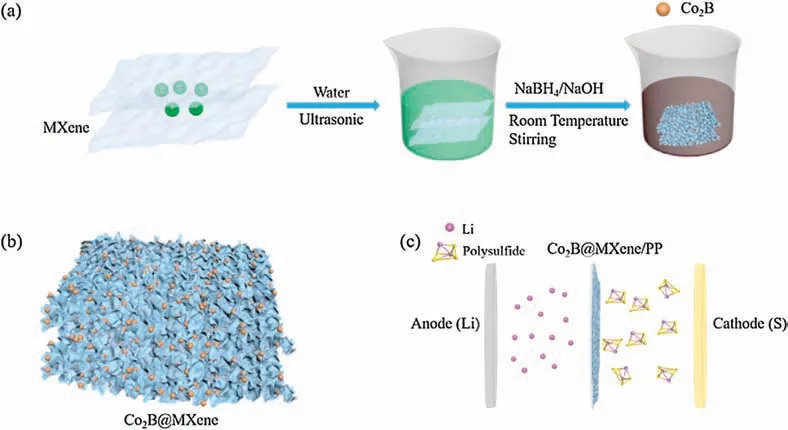
Fig.1.(a)The schematic illustration of the synthesis procedure of Co2B@MXene.(b)The schematic diagram of Co2B@MXene.(c)Schematic representation of Li-S batteries employing the Co2B@MXene separator.
X-ray diffraction patterns of Co2B@MXene and MXene were shown in Fig.2a.The XRD of MXene can be found the(002)peak,which attributes to the characteristic for the Ti3C2Tx.On the contrary, it was observed that the Co2B@MXene has no obvious characteristic peak, demonstrating the amorphous substance of Co2B [20].The X-ray photoelectron spectroscopy (XPS) analysis was performed to probe the chemical composition and valence state of the elements.The Co 2p high-resolution spectrum of Co2B and Co2B@MXene were performed as shown in Figs.2b and c.Compared with the peak of Co 2p in the Co2B,the peak of Co 2p in the Co2B@MXene moved higher binding energy.Notably,the peak of Ti 2p in the Co2B@MXene was shifted lower binding energy compared with Ti 2p of the MXene in Fig.S1 (Supporting information).These results indicated the chemical bonding of Co2B to MXene and the electron transfer from Co2B to MXene[1,15].In addition, the electron transfer made Co centers in Co2B more positively charged, promoting the attraction of more polysulfides during the reaction.More XPS information about B 1s was shown in Fig.S2 (Supporting information).Peaks for B 1s level with BE of 192.1 and 188.2 eV agreed very well with the B-O state and Co-B state,which were typical species in transition metal borides.The XPS peak position of B 1s matched with the previous report [21], which proved that the Co2B material was prepared successfully.Furthermore, Raman spectroscopy of MXene and Co2B@MXene were exhibited in Fig.2d.The Raman spectroscopy of MXene nanosheets had three broad peaks at around 200,400 and 600 cm-1owing to the vibration from Ti3C2Tx[22].Moreover,the Raman spectra of Co2B@MXene peaks present a little excursion compared with MXene,which attributed to the chemical bonding of Co2B with MXene.Furthermore, the precise atomic ratio of composition was obtained by the ICP analysis and the constitution was determined as the Co2B(Table S2 in Supporting information).
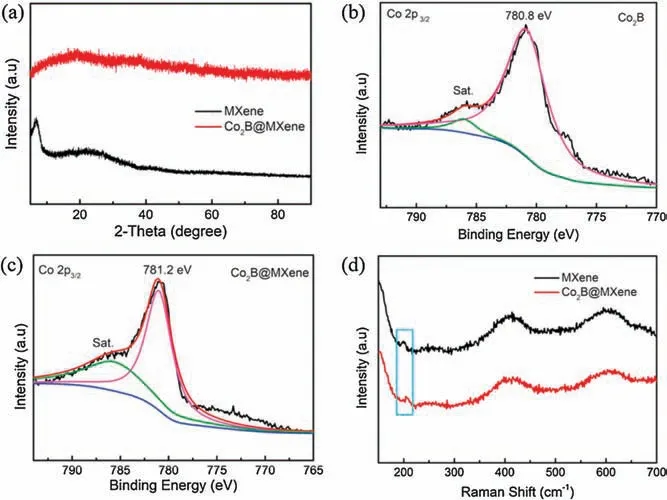
Fig.2.(a) XRD patterns of MXene and Co2B@MXene nanosheets.The Co 2p highresolution XPS spectra of (a) Co2B and (b) Co2B@MXene.(d) Raman spectra of MXene and Co2B@MXene nanosheets.
More morphology and structural characterization of Co2B@MXene were represented in Fig.3.As shown in Figs.3a–c, it was observed that the Co2B@MXene still remained an ultra-thin homogeneous layer structure, and there was no significant aggregation phenomenon.The Co2B existed on the surface of MXene and between MXene layers in Fig.S15 (Supporting information).In addition, transmission electron microscopy(TEM)and elemental mapping were used to gain more information about the Co2B@MXene.Co2B nanoparticles were grown on MXene as shown in Fig.3d.The high-resolution TEM image revealed Co2B was amorphous, which was consistent with the XRD result and a clear interface between Co2B and MXene can be noticed.Moreover,EDX elemental mapping images of Co2B@MXene also illustrated the existence of element Co, Ti, B and the uniform dispersion of Co, B and Ti atoms on the Co2B@MXene nanostructure.

Fig.3.(a-c) SEM images of the Co2B@MXene product at different magnifications.(d) The high-resolution TEM image of hetero-interface of the Co2B@MXene heterostructure.
To gain insight into the electron behavior of Co2B@MXene interface and the interfacial effect on the conversion for polysulfides,a series of theoretical calculations were implemented as shown in Fig.4.As shown in Fig.4e, the charge density difference of the Co2B@ MXene confirmed the electron migration from Co2B to MXene.The electrons(yellow)crowd at MXene while holes (wathet blue)were converged at the Co2B.Further,a model was established to probe the reason for electron transfer in Fig.4d.The Fermi level(EF)of MXene was-2.39 eV much lower than the EFof Co2B (EF= -1.12 eV).On account of the energy level difference between Co2B and MXene,electrons naturally shifted from Co2B to MXene through the interface and produce a built-in electric field[23].To further demonstrate the catalytic ability for polysulfides,we analyzed the Li2S4adsorption on the surface of pure Co2B and the Co2B of Co2B@MXene.Comparing the S--S bond length of Li2S4before and after adsorption with Co2B and Co2B@MXene, it exhibited that the Co2B and Co2B@MXene induced a longer S1-S2and S3-S4bond length of Li2S4in Figs.4a–c and Table S3(Supporting information).The longer bond length meant a weaker bond energy and the weakened S--S bond facilitated the decomposition of polysulfides [24].The S1-S2and S3-S4bond were more prolonged on the surface Co2B@MXene than that of Co2B which indicated the Co2B@MXene had stronger catalytic ability than that of Co2B.Furthermore, the adsorption energy of Li2S4on Co2B and Co2B@MXene were -1.418 eV and -2.66 eV in Fig.S13 (Supporting information), respectively.The interfacial electronic interaction between Co2B and MXene can also promote the adsorption ability of polysulfides,which was helpful to restrain their shuttling.These phenomena indicated that the influence of interfacial electronic interaction, which can improve the catalytic capacity of Co2B in Co2B@MXene and promote the conversion of polysulfides.
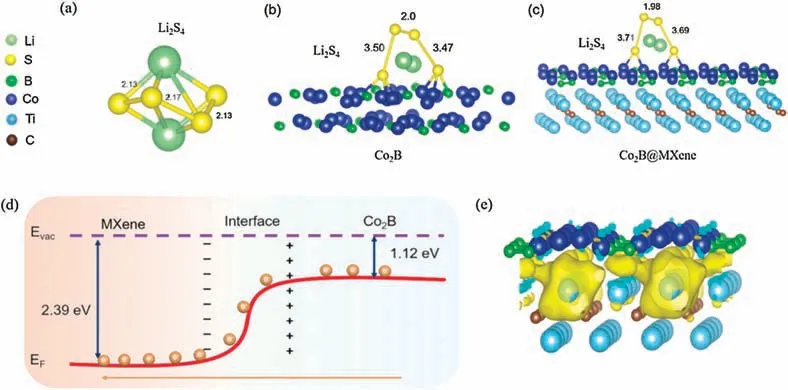
Fig.4.(a)The structural model and bond length of Li2S4.(b,c)Bond lengths of S--S after adsorption on the surface of Co2B and Co2B@MXene.(d)Schematic representing the electron redistribution at the interface between Co2B and MXene.(e) The charge density difference of the interface between Co2B and MXene.
To verify the stability and safety of the Co2B@MXene separator,we performed a series of measurements to test its performance.As shown in Fig.S4 (Supporting information), we carried out the bendable exhibition for the Co2B@MXene separator, and the Co2B@MXene did not fall off before and after folding.It confirmed that the Co2B@MXene separator had a good mechanical property.To further explore the adsorption ability of Co2B@MXene with polysulfides,the visual permeation tests were performed in Fig.S5(Supporting information).The left compartment was injected into the 0.03 mol/L Li2S6solution, and the right compartment was infused into the pure electrolyte solution,while the separator was installed between these two compartments.The Li2S6diffused through PP separator within 30 min easily in Fig.S5b, and Li2S6diffused through the Co2B separator, MXene separator within 1 h,however, the Li2S6did not permeate the Co2B@MXene separator.Even after 6 h, the solution of right compartment with Co2B@MXene separator still remained clear.This result demonstrated the Co2B@MXene had a well blocking ability to polysulfides.Moreover,the infiltrating angle between the separator and electrolyte was also an important index to evaluate the infiltration property[25].The infiltration property tests with different separators were shown in Fig.S6 (Supporting information).The contact angle of Co2B@MXene separator was 5.6°,which was the least compared to the contact angle of PP,Co2B and MXene separator,which revealed the Co2B@MXene separator had the best wettability with the minimum surface tension.
To further systematically evaluate the electrochemical performance of Co2B@MXene separator in Li-S batteries, more electrochemical properties of cell were tested with coin-type CR2025 cells.The sulfur content of CNT/S composites was 73.53 wt% in Fig.S8 (Supporting information) by thermogravimetry analysis(TGA)and the sulfur loading mass was 1.2–1.5 mg/cm2.In addition,electrochemical properties of Co2B@MXene with different thickness were further investigated to identify the optimal coating thickness.SEM images of Co2B@MXene with different thickness were shown in Figs.S7a-c(Supporting information),and the cell of Co2B@MXene with the 14.7 μm thickness emerged the best cycling performance.Therefore, we utilized Co2B@MXene separator with the 14.7 μm thickness for the following characterizations.Moreover,the electrochemical performance with different ratios of Co2B to MXene were shown in Fig.S14 (Supporting information).The cyclic voltammetric (CV) curves of cells with Co2B@MXene,MXene, Co2B and PP separator were measured at the voltage window of 1.7–2.8 V with a scan rate of 0.1 mV/s (Fig.S9 in Supporting information).The cell with Co2B@MXene separator delivered two cathodic peaks at 2.32 and 2.05 V during the discharge measurements which representing the reaction from S8to soluble Li2Sn(Li2Sn,4 To further evaluate the electrochemical performance characterization of the cell with Co2B@MXene separators,some measures were carried out.Fig.5a exhibited the initial galvanostatic charge/discharge curves of the cell with Co2B@MXene separator,Co2B separator, MXene separator and PP separator at 0.1 C(1 C=1675 mAh/g) with a voltage window of 1.7–2.8 V.The discharging profile had two reduction plateaus,demonstrating the conversion of sulfur to Li2Sn(4 Fig.5.(a)Galvanostatic charge-discharge voltage profiles at 0.1 C of the cell with PP separator, MXene separator, Co2B separator and Co2B@MXene separator.(b)The rate performance of the cell with PP separator, MXene separator, Co2B separator and Co2B@MXene separator.(c) The cycling performance of the cell at 0.5 C with PP separator, MXene separator, Co2B separator and Co2B@Mxene separator.(d)The cycling performance of the cell at 0.2 C with high sulfur loading.(e) Long life cycle performance and Coulombic efficiency of the cell with Co2B@Mxene separator at 2 C. To further investigate the electrochemical performance of Co2B@MXene under high rate condition,the tests were carried out as shown in Fig.5b.The cell with Co2B@MXene separator exhibited good rate performance with the current range from 0.1 C to 5 C.When the current density at 0.1,0.2,0.5,1.0,2.0 and 5.0 C,the cell with Co2B@MXene separator delivered steady cycling discharge specific capacities of 1566, 1374, 1169, 917, 775 and 597 mAh/g,individually.Meanwhile, the cell with MXene, Co2B and PP separator delivered capacities of 1322, 1112, 923, 740, 566,478 mAh/g, 1160, 1058, 902, 769, 596, 502 mAh/g and 1118, 895,665, 509, 397 and 209 mAh/g at 0.1, 0.2, 0.5, 1, 2 and 5 C,respectively.Even at 5C current density,the cell with Co2B@MXene separator also displayed an outstanding high discharge capacity of 597 mAh/g, illustrating that the Co2B@MXene promoted the utilization of sulfur and retarded the “shuttle effect” effectively. To detect the cycling stability of the cell with different separators,cycling performances were carried out at 0.5 C current density in Fig.5c.The cell with Co2B@MXene exhibited an initial discharge capacity at 1276 mAh/g and presented a high capacity retention of 1061 mAh/g after 100 cycles with the 0.168%per cycle average capacity decay rate.On the contrast,the discharge specific capacity of the cell with MXene, Co2B and PP separator were 956 mAh/g(0.323%decay rate),901 mAh/g(0.286%decay rate)and 670 mAh/g (0.414% decay rate), individually.This result indicated the Co2B@MXene can improve the cycling stability and enhance specific capacity effectively.As shown in Fig.5d,the areal capacity of the cell with Co2B@MXene was 5.2 mAh/cm2and reserved 4.1 mAh/cm2after 100 cycles at 0.2 C with the sulfur mass loading of 5.1 mg/cm2.It should be noted that the cell with Co2B@MXene maintained good cycle stability than cell with MXene,Co2B and PP separator under various areal density condition, demonstrating that the Co2B@MXene not only enhanced the reaction kinetics of polysulfide but also promoted the sulfur utilization during cycling.Moreover, the long-life cycling performance of lithium-sulfur battery with Co2B@MXene was measured at 2 C in Fig.5e, which displayed an initial discharge specific capacity of 786 mAh/g.The capacity decay rate of the cell with Co2B@MXene was 0.0088%per cycle after 2000 cycling, revealing an excellent long-term cycling property.Coulombic efficiency of the cell with Co2B@MXene remained over 98%,indicating high reversible conversion reaction of polysulfide. To further explore the effect of Co2B@MXene on electrochemical kinetics before and after cycling, the electrochemical impedance spectroscopy (EIS) were measured in Fig.S11 (Supporting information).The cell with Co2B@MXene separator exhibited the smallest polarization resistance as shown in Fig.S11a.Besides,the change of the impedance of Co2B@MXene was significantly smaller than that of others,suggesting Co2B@MXene can promote the conversion of polysulfides.These results also indicated that Co2B@MXene not only immobilized the polysulfide, but also enhanced rapid conversion reaction of polysulfides. The more electrochemical characteristics of different separators were measured in the Fig.S12 (Supporting information).The lithium ion conductivity was an index to evaluate Li+ion transport performance, and the Li+ion conductivity of different separators were measured in Fig.S12a and Table S1(Supporting information).The lithium ion conductivity was calculated by σ = l/(Rb×A),according to the semicircular loop in high frequency region of EIS curves.The conductivity of Co2B@MXene separator,PP separator, Co2B separator and MXene separator were 0.88 mS/cm,0.598 mS/cm,0.74 mS/cm and 0.761 mS/cm,separately.To further study the self-discharge behavior of the cell with PP,MXene,Co2B and Co2B@MXene separators,the open circuit voltage(OCV) was carried out in Fig.S12b.The cell with PP, MXene and Co2B separator appeared severe self-discharge and the OCV were 2.29 V,2.36 V and 2.34 V after 20 h.On the contrast,the OCV of cell with Co2B@MXene separator was 2.38 V,proving the Co2B@MXene suppressed the self-discharge efficiently.Besides,Li+transference was another index to estimate separator property.Li+transfer number can be acquired as shown in Figs.S12c-e through the timecurrent measurement.The Li+transfer numbers with PP, MXene,Co2B and Co2B@MXene separator were 0.715, 0.675, 0.708 and 0.733, respectively.The Co2B@MXene did not reduce the Li+transport property. In summary, we designed and fabricated a new Co2B@MXene composite as interlayer material to enhance the conversion of polysulfides and to acquire atomic-level understanding of polysulfides catalytic conversion behavior on heterogeneous material.The theoretical calculations and experiments reveal that the interfacial electronic interaction between two materials can enhance the catalytic ability and point out that the two materials with different Fermi energy levels was the intrinsic reason for the spontaneous electron transfer.The cell with Co2B@MXene delivers excellent discharge specific capacity and extraordinarily rate performance.The cell with Co2B@MXene exhibits the discharge capacity of 1577 mAh/g at 0.1 C and maintains an impressive rate capability with 597 mAh/g at 5 C.Moreover,the capacity decay of the cell with Co2B@MXene is only 0.0088% per cycle at 2 C over 2000 cycles.Even with the sulfur content of 5.1 mg/cm2, stable cycling can still be maintained over 100 cycles.This work provides a deep understanding of the effect of interfacial interaction and inspires the design and research of advanced catalytic materials for lithium-sulfur batteries. Declaration of competing interest The authors declare that they have no known competing financial interests or personal relationships that could have appeared to influence the work reported in this paper. Acknowledgments The work was supported by the State Key Laboratory of Urban Water Resource and Environment, Harbin Institute of Technology(No.2019DX13). Appendix A.Supplementary data Supplementary material related to this article canbefound, in the online version,at doi:https://doi.org/10.1016/j.cclet.2020.12.051.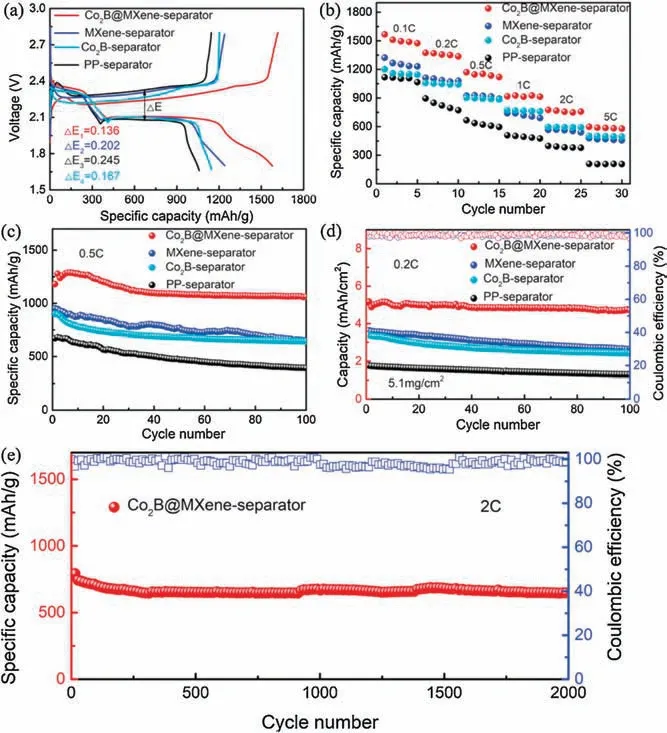
杂志排行
Chinese Chemical Letters的其它文章
- A millimeter-sized negatively charged polymer embedded with molybdenum disulfide nanosheets for efficient removal of Pb(II) from aqueous solution
- Hyperterpenoids A and B: Two pairs of unprecedented 6/6/4/6/6 polycyclic cyclobutane meroterpenoids with potent neuroprotective and anti-inflammatory activities from Hypericum beanii
- Ammonia leaching mechanism and kinetics of LiCoO2 material from spent lithium-ion batteries
- Design, synthesis and biological evaluation of pyridyl substituted benzoxazepinones as potent and selective inhibitors of aldosterone synthase
- A DNA G-quadruplex converts SOD1 into fibrillar aggregates
- Built-in piezoelectric field improved photocatalytic performance of nanoflower-like Bi2WO6 using low-power white LEDs
